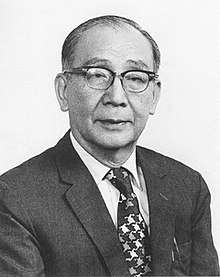Li Fang-Kuei
Li Fang-Kuei (20 August 1902 – 21 August 1987) was a Chinese linguist known for his studies of the varieties of Chinese, and for his reconstructions of Old Chinese and Proto-Tai.
Li Fang-Kuei | |||||||||||||||||||
|---|---|---|---|---|---|---|---|---|---|---|---|---|---|---|---|---|---|---|---|
 | |||||||||||||||||||
| Born | August 20, 1902 | ||||||||||||||||||
| Died | 21 August 1987 (aged 85) San Mateo County, California, United States | ||||||||||||||||||
| Nationality | Republic of China United States | ||||||||||||||||||
| Occupation | Linguist | ||||||||||||||||||
| Academic background | |||||||||||||||||||
| Education | Tsinghua University University of Michigan University of Chicago | ||||||||||||||||||
| Thesis | Mattole: An Athabaskan Language (1928) | ||||||||||||||||||
| Doctoral advisor | Edward Sapir | ||||||||||||||||||
| Academic work | |||||||||||||||||||
| Discipline | Linguistics | ||||||||||||||||||
| Institutions | Yale University Academia Sinica University of Washington University of Hawaii | ||||||||||||||||||
| Notable students | W. South Coblin David R. Knechtges | ||||||||||||||||||
| Chinese name | |||||||||||||||||||
| Chinese | 李方桂 | ||||||||||||||||||
| |||||||||||||||||||
Biography
Li Fang-Kuei was born on 20 August 1902 in Guangzhou during the final years of the Qing dynasty to a minor scholarly family from Xiyang, a small town in Shanxi roughly 50 kilometers (31 mi) south of Yangquan. Li's father Li Guangyu (Chinese: 李光宇) received his jinshi degree in 1880 and served in minor official posts in the late 19th to early 20th century.
Li was one of the first Chinese people to study linguistics outside China. Originally a student of medicine, he switched to linguistics when he went to the United States in 1924. He gained a B.A. in linguistics at the University of Michigan in 1926 after only two years of study. He then did graduate study under Edward Sapir and Leonard Bloomfield at the University of Chicago. Li conducted field studies of American Indian languages. His first exposure to fieldwork was his study of the Mattole language of northern California. He received an M.A. in 1927 and a Ph.D. in 1928, and his dissertation Mattole: An Athabaskan Language was published in 1930.
In 1929 he returned to China and, along with Y.R. Chao and Luo Changpei, became a researcher at the Institute of Historical Linguistics (Chinese: 歷史語言研究所; pinyin: Lìshǐ yǔyán yánjiūsuǒ) of the Academia Sinica (then located at Beijing). From this point on, he performed field studies of several Tai languages (including the Zhuang people's Longzhou and Wuming dialects), while at the same time conducting deep investigations into Old Chinese and Tibetan. Li's revisions of Bernhard Karlgren's reconstructions of Middle Chinese and Old Chinese were widely used by students of ancient Chinese from their publication in the 1970s until the late 1990s.
Li briefly taught Chinese language and linguistics at Yale University in 1938–39, and after World War II was professor of Chinese at the University of Washington from 1949 to 1969, and then at the University of Hawaii until his retirement. In 1977 he published a comparison of Tai languages, the result of more than forty years of research. He also worked at Academia Sinica, now in Taiwan, in 1973.
Li died in San Mateo County, California, survived by his wife Xu Ying (Chinese: 徐櫻) and their daughter Lindy Li Mark, a professor of anthropology who taught at California State University, Hayward and the Chinese University of Hong Kong, as well as their son Peter Li and daughter Annie Li.
Tsinghua University, his alma mater, began to publish his complete works in 2005.
Selected works
- Li Fang-Kuei (1933). "Certain Phonetic Influences of the Tibetan Prefixes upon the Root Initials". Bulletin of the Institute of History and Philology 6.2: 135–157.
- --------- (1956a). "The Inscriptions of the Sino-Tibetan Treaty of 821–822". T'oung p'ao 44: 1–99.
- --------- (1971), 《上古音研究》 The Tsing Hua Journal of Chinese Studies IX(1,2): 1–61, translated by Gilbert L. Mattos (1974–1975) as "Studies on Archaic Chinese", Monumenta Serica 31: 219–287.
- --------- (1972), "Language and Dialects in China". Free China Review XXII, No. 5.
- ——— (1974–1975). Translated by Mattos, Gilbert L. "Studies on Archaic Chinese". Monumenta Serica. 31: 219–287.
- ——— (1977). A handbook of comparative Tai. Manoa: University Press of Hawaii. ISBN 978-0-8248-0540-1.
- --------- (1979) "The Chinese Transcription of Tibetan Consonant Clusters". Bulletin of the Institute of History and Philology Academia Sinica 50: 231–240.
- --------- and W. South Coblin (1987). A study of the old Tibetan inscriptions. (Special publications 91.) Taipei: Academia Sinica.
- --------- (1988). Linguistics East and West: American Indian, Sino-Tibetan, and Thai. With an Introduction by George Taylor. Interviews conducted by Ning-Ping Chan and Randy LaPolla. Berkeley: The Regents of the University of California.
Further reading
- (in Chinese) Mah Feng-hua 馬逢華 (1988), "Daonian Li Fanggui xiansheng" 悼念李方桂先生 ("Remembering Mr. Li Fang-kuei"), in Zhuanji wenxue 25.2: 110–114.
- (in Chinese) Xu Ying 徐櫻 (1994). Fanggui yu wo wushiwu nian 方桂與我五十五年 (Fang-kuei's Fifty-five Years with Me) (Beijing: Shangwu yinshuguan).
External links
- Obituary by Ron and Suzanne Scollon, American Anthropologist, 1989, available through JSTOR
- Li Fang-Kuei (1902–1989), by R.J. LaPolla, in Encyclopedia of Language and Linguistics, 2nd Edition, Keith Brown (ed.), London: Elsevier, 2005, pp. 514–515. ISBN 978-0-08-044299-0.
- Li, Fang-Kuei (1986). Linguistics East and West: American Indian, Sino-Tibetan, and Thai. Berkeley: Bancroft Library, University of California. Interviews conducted by Ning-Ping Chan and Randy La Polla.
- Fanggui Li Collection, at American Philosophical Society
- "Professor Li Fang-kuei: a Personal Memoir" by Anne Yue-Hashimoto
- Li Fang-Kuei Symposium
- An interview with Li Fang-kuei
- Li Fang-Kuei Society for Chinese Linguistics